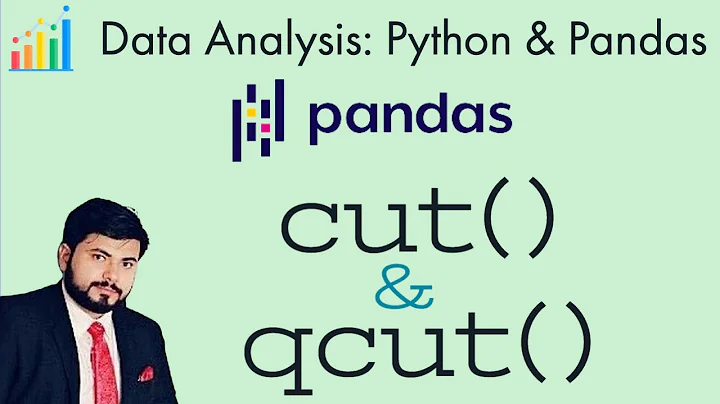Binning a column with Python Pandas
187,637
Solution 1
You can use pandas.cut:
bins = [0, 1, 5, 10, 25, 50, 100]
df['binned'] = pd.cut(df['percentage'], bins)
print (df)
percentage binned
0 46.50 (25, 50]
1 44.20 (25, 50]
2 100.00 (50, 100]
3 42.12 (25, 50]
bins = [0, 1, 5, 10, 25, 50, 100]
labels = [1,2,3,4,5,6]
df['binned'] = pd.cut(df['percentage'], bins=bins, labels=labels)
print (df)
percentage binned
0 46.50 5
1 44.20 5
2 100.00 6
3 42.12 5
bins = [0, 1, 5, 10, 25, 50, 100]
df['binned'] = np.searchsorted(bins, df['percentage'].values)
print (df)
percentage binned
0 46.50 5
1 44.20 5
2 100.00 6
3 42.12 5
...and then value_counts or groupby and aggregate size:
s = pd.cut(df['percentage'], bins=bins).value_counts()
print (s)
(25, 50] 3
(50, 100] 1
(10, 25] 0
(5, 10] 0
(1, 5] 0
(0, 1] 0
Name: percentage, dtype: int64
s = df.groupby(pd.cut(df['percentage'], bins=bins)).size()
print (s)
percentage
(0, 1] 0
(1, 5] 0
(5, 10] 0
(10, 25] 0
(25, 50] 3
(50, 100] 1
dtype: int64
By default cut returns categorical.
Series methods like Series.value_counts() will use all categories, even if some categories are not present in the data, operations in categorical.
Solution 2
Using the Numba module for speed up.
On big datasets (more than 500k), pd.cut can be quite slow for binning data.
I wrote my own function in Numba with just-in-time compilation, which is roughly six times faster:
from numba import njit
@njit
def cut(arr):
bins = np.empty(arr.shape[0])
for idx, x in enumerate(arr):
if (x >= 0) & (x < 1):
bins[idx] = 1
elif (x >= 1) & (x < 5):
bins[idx] = 2
elif (x >= 5) & (x < 10):
bins[idx] = 3
elif (x >= 10) & (x < 25):
bins[idx] = 4
elif (x >= 25) & (x < 50):
bins[idx] = 5
elif (x >= 50) & (x < 100):
bins[idx] = 6
else:
bins[idx] = 7
return bins
cut(df['percentage'].to_numpy())
# array([5., 5., 7., 5.])
Optional: you can also map it to bins as strings:
a = cut(df['percentage'].to_numpy())
conversion_dict = {1: 'bin1',
2: 'bin2',
3: 'bin3',
4: 'bin4',
5: 'bin5',
6: 'bin6',
7: 'bin7'}
bins = list(map(conversion_dict.get, a))
# ['bin5', 'bin5', 'bin7', 'bin5']
Speed comparison:
# Create a dataframe of 8 million rows for testing
dfbig = pd.concat([df]*2000000, ignore_index=True)
dfbig.shape
# (8000000, 1)
%%timeit
cut(dfbig['percentage'].to_numpy())
# 38 ms ± 616 µs per loop (mean ± standard deviation of 7 runs, 10 loops each)
%%timeit
bins = [0, 1, 5, 10, 25, 50, 100]
labels = [1,2,3,4,5,6]
pd.cut(dfbig['percentage'], bins=bins, labels=labels)
# 215 ms ± 9.76 ms per loop (mean ± standard deviation of 7 runs, 10 loops each)
Solution 3
We could also use np.select:
bins = [0, 1, 5, 10, 25, 50, 100]
df['groups'] = (np.select([df['percentage'].between(i, j, inclusive='right')
for i,j in zip(bins, bins[1:])],
[1, 2, 3, 4, 5, 6]))
Output:
percentage groups
0 46.50 5
1 44.20 5
2 100.00 6
3 42.12 5
Related videos on Youtube
Author by
Night Walker
Updated on February 25, 2022Comments
-
Night Walker about 2 years
I have a data frame column with numeric values:
df['percentage'].head() 46.5 44.2 100.0 42.12I want to see the column as bin counts:
bins = [0, 1, 5, 10, 25, 50, 100]How can I get the result as bins with their value counts?
[0, 1] bin amount [1, 5] etc [5, 10] etc ... -
qqqwww almost 6 yearswithout
bins = [0, 1, 5, 10, 25, 50, 100], can I just say create 5 bins and it will cut it by average cut? for example, i have 110 records, i want to cut them into 5 bins with 22 records in each bin. -
 jezrael almost 6 years@qqqwww - NOt sure if understand, do you think
jezrael almost 6 years@qqqwww - NOt sure if understand, do you thinkqcut? link -
 Ayan Mitra almost 4 years@qqqwww to do that, pd.cut example in its page shows it : pd.cut(np.array([1, 7, 5, 4, 6, 3]), 3) will cut the array into 3 equal parts.
Ayan Mitra almost 4 years@qqqwww to do that, pd.cut example in its page shows it : pd.cut(np.array([1, 7, 5, 4, 6, 3]), 3) will cut the array into 3 equal parts. -
 Ayan Mitra almost 4 years@jezreal can you suggest how to compute the mean of each bins also ?
Ayan Mitra almost 4 years@jezreal can you suggest how to compute the mean of each bins also ? -
 jezrael almost 4 years@AyanMitra - Do you think
jezrael almost 4 years@AyanMitra - Do you thinkdf.groupby(pd.cut(df['percentage'], bins=bins)).mean()? -
Stav Cohen almost 3 yearsThank you this answer helped me :)
-
Say OL over 2 yearsIs there any way to find mean of the data given in class table (not mean of the count)
-
 goryh almost 2 yearsI would be interested to see how this compares speed wise with the cut solution.
goryh almost 2 yearsI would be interested to see how this compares speed wise with the cut solution.







